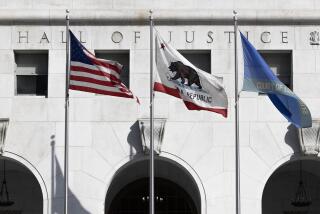D.A. Allowed to Prosecute Officials’ Case
SANTA ANA — In a legal setback to the three elected officials facing charges for their role in Orange County’s bankruptcy, a judge ruled Friday that Dist. Atty. Michael R. Capizzi had no conflict of interest and would remain the prosecutor in their misconduct cases.
During a lengthy court hearing on the matter, Los Angeles Superior Court Judge John W. Ouderkirk rejected every argument advanced by attorneys for Auditor-Controller Steve E. Lewis and Supervisors Roger R. Stanton and William G. Steiner, who had sought to have Capizzi disqualified.
“There is no conflict so grave that the defendants would not receive a fair trial,” said Ouderkirk, who added that “the defendants have failed to meet their burden” of proving that Capizzi’s office could not be evenhanded in dealing with the cases.
Since early December, only days before the grand jury issued charges against the three for “willful misconduct” in office, the defendants have accused Capizzi of being as much to blame as anyone for failing to act on a 1993 audit report by Lewis.
In that report, Lewis drew attention to illegal investments being made by then-Treasurer Robert L. Citron, and a lack of adequate controls in Citron’s office, which ran the county investment pool that lost $1.64 billion, plunging the county into bankruptcy.
The cover letter on Lewis’ report indicated that it had been sent to the five sitting supervisors, as well as to Capizzi’s office. The report was transmitted to the Board of Supervisors in a way that would keep it off of the public agenda.
Citing what he called the “credible” testimony of Capizzi and Assistant Dist. Atty. Wallace J. Wade, Ouderkirk concluded that “Mr. Capizzi did not receive, or know of the report or its contents prior to December of 1994,” when the full extent of Citron’s investment losses were first made public.
“It may well be that the report was never sent to the office of the district attorney,” the judge continued, adding that the “format” and the way the report was transmitted “seemed . . . designed to obscure its contents.”
Lewis has claimed that he provided adequate warning to top county officials in the audit of the treasurer’s 1991 operations, because it disclosed that Citron’s investment practices often violated state law.
During the hearing, Capizzi testified that he never received the audit, and didn’t even hear of it until it was described in an article published by The Times after the county filed for bankruptcy in December 1994.
The judge also flatly rejected defense claims that Capizzi had interfered with the Orange County Grand Jury that charged Lewis and the supervisors in order to thwart its civil investigation of the bankruptcy, including questions grand jurors might have had about why Capizzi didn’t look into Citron’s investments sooner.
The defense claimed Capizzi improperly threatened to impanel a second grand jury to consider criminal charges related to the bankruptcy if the existing grand jury proceeded with its civil probe.
Prosecutors did indeed mention the possibility of convening a second grand jury, because they feared that information gathered during a civil investigation might “taint” the outcome of the grand jury’s consideration of criminality, according to court documents.
Ouderkirk said “the district attorney acted in good faith and with an abundance of caution” to avoid any question that the grand jury considered anything other than sworn testimony in reaching decisions on any criminal indictments it might issue. The judge added that Capizzi’s “advice was reasonable and probably wise.”
After hearing final arguments last week, Ouderkirk asked the district attorney’s office to provide a written explanation of how it had decided to seek charges against Stanton, knowing that his term will end this year.
The judge noted that the worst thing that could happen if Stanton is convicted at a trial later this year is removal from office, and that he will leave office at year’s end anyway.
After reading the explanation, Ouderkirk said he was satisfied that the district attorney had “recognized the issue and rationally evaluated” it.
The judge also ruled that neither Capizzi nor his office had been unduly influenced by the bankruptcy, even though it cost his four top deputies substantial pay raises that had been scheduled--and then canceled shortly after the bankruptcy petition was filed.
Ouderkirk said he had had “ample opportunity” to watch Capizzi’s staff and he felt they conducted themselves as “even-handed and professional advocates.”
After the hearing, attorneys for the two supervisors said they would challenge the ruling.
“We think the judge is clearly wrong,” said Allan H. Stokke, Steiner’s attorney. “He gave us a full hearing but we disagree with his findings. The Court of Appeals will be the next step.”
Stanton’s attorney, Vincent J. LaBarbera, echoed those sentiments. “Roger Stanton is also going to take this up to the Court of Appeals,” he said.
Capizzi said he had been “confident from the outset that there was absolutely no basis for” the claims of conflicts of interest, adding, “It’s gratifying to have the judge determine that and to repudiate the allegations with such strong statements.”
Capizzi said he expects the case to now meet Ouderkirk’s scheduled Sept. 9 trial date:
“The judge made it very clear he’s intent on getting it underway by then and hopefully the defendants will likewise be eager to get it resolved.”
More to Read
Sign up for Essential California
The most important California stories and recommendations in your inbox every morning.
You may occasionally receive promotional content from the Los Angeles Times.










